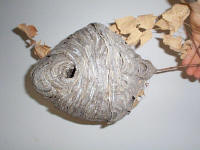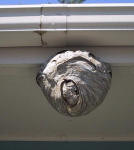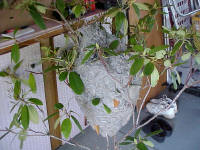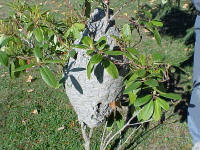Bald-faced hornet / White-faced hornet
|
|
|
|
|
Die Kasteneinteilung der baldfaced hornet ist - wie bei den sozialen Faltenwespen üblich - dreiteilig:
Königin (Vollweibchen)
Arbeiterin (Hilfsweibchen)
Drohn (Männchen)
Übrigens ist das schwarz-weiße Farbmuster nur aus unserer (europäischen) Sicht exotisch und ungewöhnlich anmutend.
Für viele soziale Faltenwespenarten in Fernost ist hingegen genau diese Farbgebung typisch. Ein interessantes Beispiel dafür ist die Rote Wespe (Vespula rufa), die etwa hinter dem Fluß Lena in Sibirien nicht nur ihre rötlichen Flecken verliert, sondern auch ihre gelbe Grundfarbe nach Osten hin allmählich in ein bläßliches Weiß ändert (= Vespula rufa schrenckii)!
Nachstehende Fotos: Michael Ellestad,
USA

Orginal E-Mail von Michael Ellestad:
This huge bald faced hornet nest -
found near a park - from 1999 was at least over a foot in diameter but
it is very elongated and has a very small entry hole.
Miniaturen zur Großansicht
bitte anklicken



Das Nest weist anfänglich oft einen nach unten gerichteten Eingangstunnel auf, der aber im Verlauf des weiteren Nestbaus wieder rückgebaut wird.


Orginal E-Mail von Michael Ellestad:
Heres photos of live bald-faced hornet nest on
ladder. This is the first time I have shot photos of a live nest. The wet looking spots are area
where new pulp was being added. They were taken in the dark because during the day I was afraid
to get too close so I did it at night which let me get closer.
Miniaturen zur Großansicht
bitte anklicken




Fotos
von Terri aus Southwestern
Pennsyvania

Orginal
E-Mail von H Parker:
I do regret not documenting the progress of the growth of the nest from
the last week in May when it was only the size of a golf ball. We just
were pleased to watch it grow! We never had the large number of hornets at
any given time that your site information indicates and as did the Yellow
jackets. It is amazing how so few hornets were able to construct the nest
to the size it is now. I wonder if our Northwest Washington State does not
have the large swarms of them as other areas of north America. Very few
people we have spoken to about the Bald Face Hornet are not even aware of
their existence at least in our immediate area.
Miniaturen zur Großansicht
bitte anklicken




Fotos: Barbara H Parker



Orginal
E-Mail von David Taylor:
I work in woods in Kentucky, USA, and occasionally find
individuals or their nests. While somewhat nervous around
them, they are fun to watch as they capture prey. I have also had
experience with the bald-faced hornet in the woods. More than once I
have had numerous individuals pluck flies off of my clothing. At first it
was terribly unnerving to be surround by them. When I realized what they
were doing, I relaxed and watch with amazement. They fly in with legs
together like a basket, scoop the fly up and hold it.
Orginal
E-Mail von David Bishop:
This nest was located in a heavily wooded area near our home and is the larger
by half again from any we'd ever seen before.
This was located in a nearby wooded area by our home in San Rafael, California just last week. Making a capture net from an old pool strainer and plastic garbage bag and using an extendable pruner we were able to detach it from it's support branches without any damage. What makes this feat even more impressive is that we( my wife and I) did this at night with two daughters running around with the flashlight like yellowjackets themselves It was about fifteen feet in the air over a steep hillside between two bay laurel trees. The color is strikingly different from the ones displayed in your site. It may be that the source of their pulp is the local madrone and eucalyptus, both of which are deep brown and reddish in their outer bark. Perhaps it may also be that the wood pulp hasn't bleached to grey since it was in such a heavily wooded area. SInce finding this one we've become aware of two others and are quite pleased to be able to provide them to our local schools' science rooms. It's been a great pleasure introducing children to this aspect of the natural world that otherwise strikes fear.
Orginal
E-Mail von M Seymour:
I first learned about them when I worked on a farm where we raised two
open barns full of veal calves each summer. I was nervous about working in
the barns because there were bald-faced hornets flying around in there and
I thought they must have a nest nearby. After I expressed my concern, the
farm manager observed them one afternoon to try to find the nest and when
I came to work the next day, he had me come watch them with him. They were
catching flies! The nest was in a pumphouse 40 feet away from the barns
and for two summers I fed in those outside barns twice a day and was never
stung. I WAS occasionally dive bombed for a tempting-looking mole on my
cheek that apparently looks like a fly to a bald-faced hornet....... I
know this alone would panic people with a bee phobia, but I got used to
it. In fact, this nearsighted optimism made me like them even better! And
I was thrilled to see those irritating flies ending up as someone's dinner!
Since then I've watched them carefully. They hunt around my white car that
flies love to land on in the late summer and fall. They harvest cedar from
the rail fence near my front door and I can hear them chewing the fibers
off. They love the small sweet flowers of a wild vine called squirting
cucumber that grows here, and they (as the pictures at your site show)
make the most beautiful and amazing nests. All in all a most
interesting, helpful and wonderful insect.
Orginal
E-Mail von Garland J. Hoops
Hello, I walked out my door the other morning at 5:30 AM on
my way to work,on the short walk from my door & my jeep I was stung on the arm
by a Bald Faced Hornet, OUCH. Well I have been looking for ways to kill the
Hornets in there nest since then UNTIL I happened to run across your web site,
Now I don't think I want to kill them. I'm still not sure why it stung me as
it's nest is across the street from my house attached to a cable box close to a
telephone pole. I figure maybe they were disoriented by my outside light & one
was sitting on my screen door & when I came out it was startled so it attacked.
I am attaching a couple pic's I took of the nest with my digital camera, I will
be taking photo's of the nest with my 35mm camera & if you like I will send you
the pic's. I am located in Newark, Delaware USA. Thanks for all the Great info
on your website.
Sincerely,
Garland J. Hoops
Miniaturen zur Großansicht
bitte anklicken


Fotos: Garland J. Hoops
Orginal
E-Mail von
Mark Laws
"Actually I was going to a cellular site here in St.Louis Missouri to do
some maintenance work. I looked up and noticed a large nest of white faced
hornets and I stoped took some pictures. I thought it was interesting so I
found your website and sent you the picture. Also I noticed that the
migration of these's HornetsWest Coast and South East, I found then In the
Mid-West??? Go ahead and use my pictures on your website.... "
Miniaturen zur Großansicht
bitte anklicken


Fotos:
Mark Laws
Orginal
E-Mail von Lynn Passamonte
"We found this in our back yard this summer {
August, 2003}. We had a pool with a deck and on one end of the deck we have a
very large Rhododendron Bush. This past Spring we took down our pool so the bush
was wide open. Your sight has been of the upmost help to us. We cut it down
today { November 9th} and measured it. It is 41" around the middle and stands
27" high. We are taking it to our Daughter's who is a 6th grade teacher. She
wants to use it in her classroom. We have never seen a nest as large and very
active as this one. I'm sending along some pictures I took this morning. Thank
you again for your web site."
Miniaturen zur Großansicht
bitte anklicken



Fotos: Lynn Passamonte

Orginal E-Mail of Corey Bryant
"Make no mistake about it: Bald-faced hornets
are extremely protective of their nest and will sting repeatedly if disturbed.
But they are the most docile hornet and fairly gentle outside the nest area."

Fotos: Rita Gale

Foto:
Arlene Ripley
Nächste Seite: "Fachchinesisch" - alphabetisch geordnet
Hymenoptera>Vespoidea>Vespidae>Vespa
crabro>Hornisse>Hornet>Frelon>Hoornaar>Vespa
grande>Abejorro>Calabrone
Hymenoptera>Vespoidea>Vespidae>Vespa
crabro>Hornisse>Hornet>Frelon>Hoornaar>Vespa grande>Abejorro>Calabrone
Webmaster:
Dieter Kosmeier
Hymenoptera>Vespoidea>Vespidae>Vespa
crabro>Hornisse>Hornet>Frelon>Hoornaar>Vespa grande>Abejorro>Calabrone
Hymenoptera>Vespoidea>Vespidae>Vespa
crabro>Hornisse>Hornet>Frelon>Hoornaar>Vespa grande>Abejorro>Calabrone
















